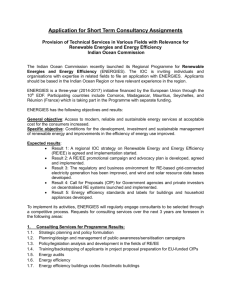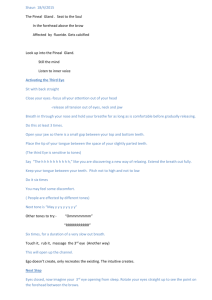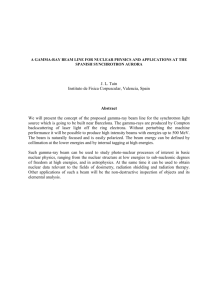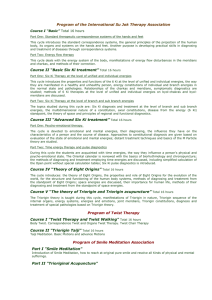Subtle Energies Viewed from Four Quadrants
advertisement
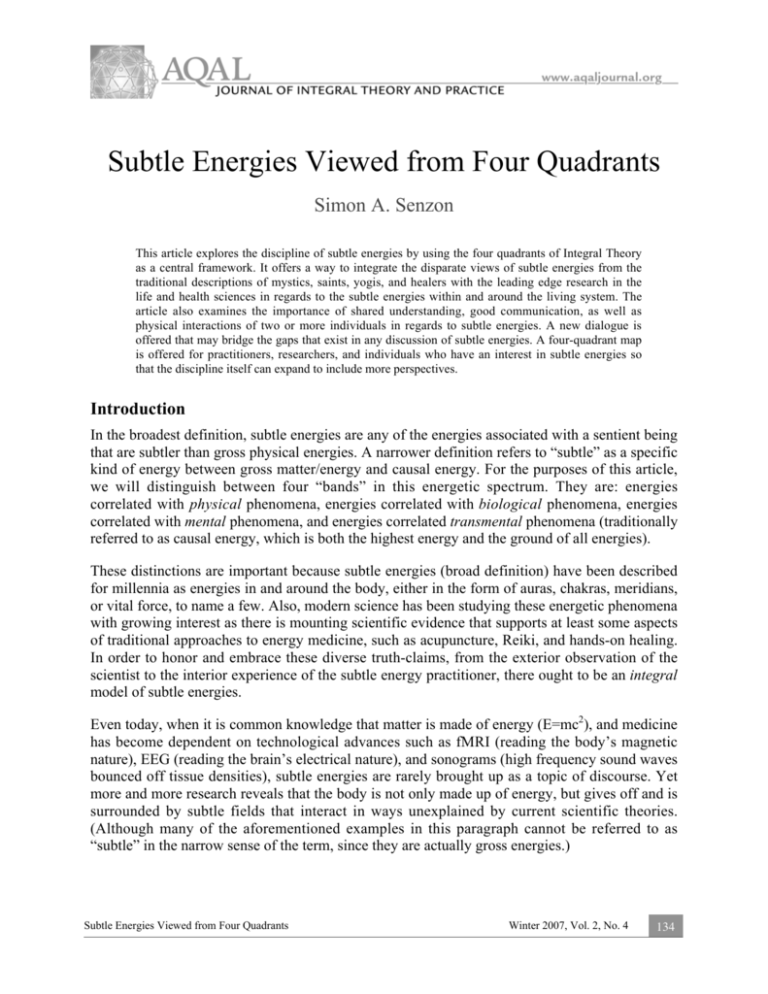
Subtle Energies Viewed from Four Quadrants Simon A. Senzon This article explores the discipline of subtle energies by using the four quadrants of Integral Theory as a central framework. It offers a way to integrate the disparate views of subtle energies from the traditional descriptions of mystics, saints, yogis, and healers with the leading edge research in the life and health sciences in regards to the subtle energies within and around the living system. The article also examines the importance of shared understanding, good communication, as well as physical interactions of two or more individuals in regards to subtle energies. A new dialogue is offered that may bridge the gaps that exist in any discussion of subtle energies. A four-quadrant map is offered for practitioners, researchers, and individuals who have an interest in subtle energies so that the discipline itself can expand to include more perspectives. Introduction In the broadest definition, subtle energies are any of the energies associated with a sentient being that are subtler than gross physical energies. A narrower definition refers to “subtle” as a specific kind of energy between gross matter/energy and causal energy. For the purposes of this article, we will distinguish between four “bands” in this energetic spectrum. They are: energies correlated with physical phenomena, energies correlated with biological phenomena, energies correlated with mental phenomena, and energies correlated transmental phenomena (traditionally referred to as causal energy, which is both the highest energy and the ground of all energies). These distinctions are important because subtle energies (broad definition) have been described for millennia as energies in and around the body, either in the form of auras, chakras, meridians, or vital force, to name a few. Also, modern science has been studying these energetic phenomena with growing interest as there is mounting scientific evidence that supports at least some aspects of traditional approaches to energy medicine, such as acupuncture, Reiki, and hands-on healing. In order to honor and embrace these diverse truth-claims, from the exterior observation of the scientist to the interior experience of the subtle energy practitioner, there ought to be an integral model of subtle energies. Even today, when it is common knowledge that matter is made of energy (E=mc2), and medicine has become dependent on technological advances such as fMRI (reading the body’s magnetic nature), EEG (reading the brain’s electrical nature), and sonograms (high frequency sound waves bounced off tissue densities), subtle energies are rarely brought up as a topic of discourse. Yet more and more research reveals that the body is not only made up of energy, but gives off and is surrounded by subtle fields that interact in ways unexplained by current scientific theories. (Although many of the aforementioned examples in this paragraph cannot be referred to as “subtle” in the narrow sense of the term, since they are actually gross energies.) Subtle Energies Viewed from Four Quadrants Winter 2007, Vol. 2, No. 4 134 The intent of this article is to begin a basic outline of an integral approach to subtle energies by using philosopher Ken Wilber’s Integral Theory. Integral Theory is comprised of five elements: quadrants, levels, lines, states, and types. As this is an introduction to the topic, I will focus mainly on quadrants, which represent four basic perspectives that can be taken on any event. In our context, the levels of energy can be described as gross, subtle, and causal, or as noted above, physical, biological, mental, and transmental. Traditionally, these levels of subtle energy have been referred to as etheric, astral, psychic, and causal. While the emphasis of the paper will be on the quadrants, it is important to understand that levels are the next logical step of complexity to be described. This approach will allow a comprehensive yet coherent discussion of subtle energies and will also create a foundation for future research and theory building. I will look at each quadrant in relation to subtle energies and show how this simple map clarifies the discipline of subtle energies into an easy-to-use model. The Four Quadrants As mentioned above, the four quadrants describe four basic perspectives that anyone can view the world through. They can be referred to by the pronouns that are often used when we inhabit each of these perspectives: “I,” “We,” “It,” and “Its.” These four perspectives represent the interior and exterior of the individual and the collective. (See figure 1.) Figure 1. The Four Quadrants For example, I can have an interior-individual experience, which represents my first-person perspective as an “I.” I can have an interior-collective experience with “You” (second person), where “We” (first-person plural) experience mutual resonance and understanding. I can also Subtle Energies Viewed from Four Quadrants Winter 2007, Vol. 2, No. 4 135 observe the exterior of an individual “It” through a third-person singular perspective. Thirdperson perspective can also be plural, such as when I observe multiple parts interacting in a system of “Its,” or the exterior-collective. These four perspectives of “I,” “We,” “It,” and “Its” comprise the four quadrants; the Upper-Left quadrant represents “I,” the Lower-Left quadrant represents “We,” the Upper-Right quadrant represents “It,” and the Lower-Right quadrant represents “Its.” The four quadrants provide a map through which we can navigate the territory of subtle energies. By acknowledging that each interior experience has an exterior correlate, that for every experience of consciousness (UL) there is a correlating matter/energy expression (UR), and that for each interior cultural worldview (LL) there is an exterior social structure (LR), the importance of this approach becomes evident. Figure 2 is a brief summary of this all-quadrant approach in regards to the discipline of subtle energies. Figure 2. All-Quadrant Approach to Subtle Energies The ensuing discussion will focus on the quadrants in the following order: first, the UL, or how subtle energies are felt and perceived; second, the UR, because that is where subtle energies (as a type of mass/energy) themselves can actually be found; third, the LR, which is where the interaction between subtle energy fields takes place; and finally, the LL, which reveals the mutual felt resonances, shared understandings, and cultural contexts surrounding subtle energies. Subtle Energies Viewed from Four Quadrants Winter 2007, Vol. 2, No. 4 136 By applying this all-quadrant approach to subtle energies, researchers will benefit from the availability of a common language (i.e., an all-quadrant language), and practitioners will have a very clear map through which to chart the quadratic territory of subtle energies. Internal Experience This section is called internal experience because the focus will be on the use of awareness in relation to subtle energies. The energies themselves are represented by the UR, while the awareness or internal experience of those energies are represented in the UL. The emphasis of this section is how the internal experience can be utilized by feeling the energies, and while I will look primarily to the spiritual traditions in this regard, it should be clear that many of those traditions point to or imply this same important distinction: that energies are exterior phenomena, while the individual awareness or feeling of those energies is interior. Several spiritual traditions use techniques whereby the spiritual aspirant is taught to pay close attention to the subtle energies as they move through and around the gross body. The subtle energies (which are “in” the UR) are utilized as a focus of attention (UL), through which greater awareness is cultivated. This awareness (UL) deepens and often corresponds to an increase in the flow of the subtle energies (UR). By doing so, the aspirant increases spiritual development, vitality, and health. This correlation between interior consciousness and subtle energies can be found in traditions as diverse as Taoism, Hinduism, Buddhism, Christianity, and Judaism. In each of these traditions, there are teachings that direct the aspirant to a radical awakening of complete oneness with the essence of reality. This awakening correlates with the energies themselves as the energies are essentially viewed as the divine spark (UR) of divine consciousness (UL). Thus, by focusing on the energies as an exercise in awakening, a twofold event occurs: greater awareness of higher and higher states of consciousness (UL) and an increasing ability to access subtler and subtler forms of energy (UR). Each tradition interprets these experiences according to their lineage or culture (LL). When these traditions are examined cross-culturally, many similarities and patterns become apparent. However, the frameworks developed by premodern sages did not link the increasing complexity of matter to the increasing subtlety of energies (largely because modern science had not yet discovered much of the former).1 Thus, the traditions missed the fact that even energies associated with the very highest states of consciousness are still physically correlated with the body. They did, of course, make UR observations of the energies (through interior cultivation in UL), though not by utilizing scientific experimentation, and so the traditions were unable to make the connection that emotional energy is related to neuropeptides or that mental energy is related to the complex neo-cortex, and so on. (Take, for instance, the halos depicted by early Christian artists. These artists generally viewed a halo as an otherworldly dispensation from God and never assumed that such a glow might actually correlate with the energy associated with the triune brain in the UR.) Subtle Energies Viewed from Four Quadrants Winter 2007, Vol. 2, No. 4 137 Understanding that every interior experience (UL) has an exterior correlate (UR), or that thoughts and feelings have physical correlates like neuropeptides and brainwaves, is a conception that becomes possible with the advent of rational-empirical science. An Integral approach to subtle energies preserves this truth and suggests that even the highest spiritual experiences have physical correlates (although they cannot be reduced to physical correlates).2 This is best explained through some examples from the traditions themselves. Almost every spiritual tradition has a philosophy that describes subtle energies, as well as practices to cultivate or bring spiritual aspirants into contact with these energies. I will use brief descriptions of Advaita Vedanta, Tibetan Buddhism, and Kabbalah as examples. The primary teaching of the Advaita Vedanta aims for the spiritual aspirant to realize the nondual nature of all existence.3 One practical technique is yoga, where an awareness of the body can be developed to access various states of consciousness and their corresponding energies. The awareness is represented by the UL, while the energies themselves (and the body, for that matter) are found in the UR. There is a complex energetic anatomy found in many yogic texts consisting of energy centers called chakras, as well as lines of energy transmission in and around the spinal cord. The aspirant is taught to master these energies through a variety of techniques. In the Tibetan Buddhist tradition, the spiritual aspirant is taught to pay attention to the body as a way to discipline and concentrate the mind.4 Thus, once again, awareness is cultivated in the UL while the changes in the body and its associated energies occur in the UR. The spiritual aspirant is taught to use these energies to gain greater awareness of higher states of consciousness. There are specific Tibetan terms that represent the energies and roughly translate into “wheels,” “drops,” and “winds.” By cultivating the ability to access subtle energies, the aspirant can learn to master these states, which Tibetan Buddhism considers an essential skill for navigating this life (as well as the afterlife). Another tradition that teaches about cultivating awareness through noticing subtle energies is Kabbalah, the mystical core of Judaism.5 Just as in Buddhist and Hindu traditions, Kabbalah asserts that there are energy centers that correspond with certain aspects of the body. These energy stations are generally depicted by ten sefirot. Again, like the other systems, aspirants in Kabbalah are taught to use their awareness (UL) of the energies (UR) so that they can awaken to higher states of consciousness and access more of these energies, thus achieving deeper and deeper union with the Divine source. The mastery of gross, subtle, and causal energy in the Upper Right helps to access, respectively, gross, subtle, and causal consciousness in the Upper Left. While you can access consciousness directly, which can be somewhat arduous or prolonged, contacting their relative subtle energies is said to be a short or tantric path to realization. I will end this section with a final example, one involving a practitioner of some form of energy healing. In the process of energy work, the practitioner has an internal experience (UL) of the Subtle Energies Viewed from Four Quadrants Winter 2007, Vol. 2, No. 4 138 energies that their client is “emanating” (UR). The client also has an internal experience (UL) of the energies (UR) as they move through their body. The energies themselves are physically moving in the (UR), while the internal experience or state of awareness associated with that movement of energy takes place in their awareness (UL). At this point, we can see how valuable the four-quadrant map is in regards to simply keeping track of subtle energies. More importantly, by using this all-quadrant approach, the lasting truths of the contemplative traditions, as well as their limitations, can now be accounted for. Subtle Energy Research A discussion about research into subtle energies instantly runs into certain limitations. While it is evident that modern science has established that the physical body is in fact matter/energy and that there is validity to various aspects of subtle energies such as acupuncture meridians, acupoints, and the initial levels of the auric field, there are still greater claims about subtle energies that science has not investigated.6 One solution to this dilemma is to posit two approaches to subtle energies, one that posits gross matter/energies (the conventional energies) and one that hypothesizes that there is still more to be discovered (non-conventional energies). Both solutions are predicated on Wilber’s hypothesis that as matter increases in complexity (Upper-Right quadrant), each new level of complexity is comprised of subtler and subtler energies.7 This hypothesis fits with the traditions, who all agree that there is a spectrum of at least three to five basic levels of subtle energy: physical/gross, emotional, mental, soul, and spiritual. This is where levels within Integral Theory become very important for our discussion. The first three levels of energy have in part been found as extremely complex forms of gross matter/energy, the higher levels have not.8 The first solution, that some aspects of subtle energies can be described as gross matter/energies, will fit all of the research discussed in this section. The second solution, that there may be nonconventional energies that science has not yet discovered, which have been felt by sensitive people, mystics, and healers for millennia, can remain a hypothesis, precisely because those same individuals felt the energies that have been found as matter/energy. If science was able to prove that acupuncture meridians exist for example, and since this was first discovered through intuitive felt awareness (Upper Left), then it is possible that there are still other things that the premodern sages discovered through internal awareness that may still be found by science, perhaps a fifth or sixth force (in addition to the four known forces of physics). After all, these energies, which have not been physically found such as the causal field, can still be felt by sensitive individuals who perform specific exercises or practices prescribed by various contemplative traditions for ages. You can feel them as well if you perform the practices. And, as dictated by all of the subtle energy healing traditions, you can act on these energies and cause specific physical/gross changes. Integral Theory allows for the possibility for both types of subtle energies to exist, conventional and non-conventional, and for the possibility that the non- Subtle Energies Viewed from Four Quadrants Winter 2007, Vol. 2, No. 4 139 conventional energies are superimposed upon the conventional energies. What will be discussed below are the research studies linking conventional energies to the subtle energies. Starting with the sages, as noted above, there have been complex descriptions throughout the world’s wisdom traditions about the actual energetic anatomy within the human, which is related to an auric field around the human that can be broken down into a series of levels. This auric field is traditionally described in successive layers relating to life, emotion, thought, soul, and spirit (often referred to as energy bodies). According to Wilber, the evidence in the Upper-Right quadrant is suggestive that some of the traditional layers of the field are actually detectable using scientific methods within today’s reach, specifically the layers supporting life, emotion, and to some degree thought.9 We have seen that although the sages made explicit observations of the energies themselves, they did not correlate them to the complexification of the body or matter. As Wilber notes, they did not correlate them to the increasing complexity of gross form. Wilber hypothesizes that each of the levels of the auric field described above correlates with increasing levels of complexity: the vital energy level correlates to cells, the emotional level to early nervous systems, the mental level to more complex nervous systems (e.g., in mammals), the soul level with a complex neocortex (i.e., humans), and the highest level of spirit to the long-time meditator and the specific brainwave patterns and neural networks produced therein.10 This notion of each new subtle energy level enveloping the levels below it brings us to the concept of holons. A holon is a whole that is a part of another whole—in other words, a holon is a whole/part. Each new whole, which emerged on the evolutionary scene, becomes a part of the next more complex whole. For example, a molecule includes an atom within it but is itself included in a cell. It is a whole and a part simultaneously. Every sentient holon has all four dimensions (represented by the quadrants) as part of its makeup: “I,” “We,” “It,” and “Its.” Let us begin with research relating to the energetic anatomy. We can then examine some of the research relating to energetic fields around the body. Afterwards, we will examine just how utilizing an all-quadrant map can assist subtle energy researchers and practitioners alike. One exemplary approach to the energy anatomy is the ancient Chinese system of acupuncture meridians and acupoints. Since this particular system was developed before the advent of modern science, it is assumed that the ancient Chinese used some form of intuitive awareness (UL) to map out these energetic phenomena (UR). Modern science is proving that meridians and acupoints do, in fact, exist.11 To some researchers, the meridians are considered a fifth circulatory system since they act as channels in the body through which subtle energy circulates.12 Other research has shown that acupuncture meridians act as “waveguides”: they can carry acoustic waves and microwaves.13 It has also been suggested that the meridian system exists within the spaces between the blood vessels.14 Other researchers have found channels of conductivity through the connective tissue that allow electron flow, which they compare to the Taoist concept of Chi or energy.15 It is also known that the acupoints and the meridians generate Subtle Energies Viewed from Four Quadrants Winter 2007, Vol. 2, No. 4 140 electrical transmission and that the points themselves are in areas of the highest electromagnetic field strength, or “at the peaks of electromagnetic standing waves.”16 This empirical evidence for meridians and acupoints does not subtract from the original insights of the premodern sages but rather supplements their understanding of subtle energies by fleshing out the details of the UR. Hence, this is another example of how the quadrants are useful, as interior illuminations (UL) are tracked via their external correlations (UR). Such an approach adds new insights to the traditions, insights that could not have been found without UR science. Thus, the practitioner of Chinese medicine is actually supported in their practice by having scientific backing. Another way that UR studies contextualize UL insights is with research into the occurrence of energy fields around the body. Most of the ancient traditions attribute some type of subtle (auric) energetic field around the body, and modern research seems to confirm this. Researchers such as Rubik and Oschman have suggested that the combination of all cells, molecules, organs, and tissues in the body actually creates such a field.17 Other researchers, including Burr and Hunt, have delineated several layers to the field around the body, even going so far as to designate a basic auric field, an emotional field, and a thought field.18 An all-quadrant approach is extremely useful for researchers because it allows them to clearly differentiate between the UR and UL. By acknowledging that states of consciousness are correlatively associated with subtle energies, the language used to describe scientific findings can be much more precise. According to the traditions, the fields of matter/energy can be understood as the physical support that states of consciousness rest upon, just like the mind relies on the structures of the brain. This distinction will be crucial in the next section when discussing the Lower-Right quadrant, since that is where interactions between fields are represented. When Energies Interact The Lower-Right quadrant represents the interobjective or social domain, where two or more fields of subtle energies interact. This is so because whenever two sentient holons interact, their subtle energy fields interact, and a new, distinct “energetic fingerprint” emerges. The most commonly discussed interaction of subtle energies takes place in the healing traditions, where the practitioner is consciously attempting to manipulate subtle energies in some fashion. These types of interactions include: healing at a distance, the emanations of energy from a healer’s hands, and any interaction between a practitioner and client that involves subtle energies. In this section, I will choose the tradition of massage therapy (specifically, massage therapy that aims to manipulate energy) as an example and look at it from all four quadrants. This will provide a framework for applying the four quadrants to any healing tradition, including Therapeutic Touch, Polarity Therapy, Chi Kung, Reiki, Shiatsu, Acupuncture, Ayurveda, Network Spinal Analysis, and Brennan Healing Science. (I should also mention that of those approaches, Network Spinal Analysis is currently the only one informed by Integral Theory.)19 Subtle Energies Viewed from Four Quadrants Winter 2007, Vol. 2, No. 4 141 Our imaginary massage therapist greets her client and conducts an examination and interview to determine what is the most therapeutic course of action. The therapy session ensues and the client opens to greater interior depths by allowing this energy to move and tension and emotion to release. The session ends, and the practitioner explains what she did while the client explains what was felt. A closer look will allow us to notice the four quadrants in greater detail. Represented in the Upper-Right quadrant, the practitioner first makes some type of assessment of the client, such as the energy flow through the body, tension of the muscles, and overall impression of the client’s body as a whole. The practitioner may also be able to determine certain types of energies in the client’s body that relate specifically to interior states and stages of consciousness. Represented in the Lower-Right quadrant, there is an interaction between the practitioner and client whereby the protocol or therapy of manipulating energy is established. When everything is “just right,” an energetic connection may happen, which is a distinct and unique field of exchange between the two. The Lower-Left quadrant represents where the felt resonance occurs between the practitioner and recipient and also represents the cultural context through which they interpret their interaction and give it meaning. The Upper-Left quadrant represents where we can discuss the client and the practitioner’s internal experiences. Furthermore, by understanding developmental stages of psychological growth in the UL, the practitioner can better assess just how to communicate to the client. By consciously acknowledging that these four perspectives are already there, the practitioner can develop an all-quadrant approach and ensure that the realities associated with each quadrant are being included. This will add depth to the experience for both individuals. For example, by acknowledging the importance of mutual understanding (LL), the practitioner may take extra time to communicate about the subtle energetic components (UR and LR) of the modality, as this will add validity to the client’s own internal experience (UL). By doing so, the client has the opportunity to not only feel relief and energy flow, but also a new sense of success. This type of communication in the “We” domain is important because subtle energies are often very challenging for most people to understand. Mutual Understanding Any view of subtle energies is molded by LL cultural values and mutually agreed upon beliefs, which themselves are simultaneously influenced by empirical evidence in the UR and the social institutions of the LR. Historically, this can be seen in the transition from one epoch to another, such as the dawn of rationality and the “Enlightenment” in the West. Take Leonardo Da Vinci as an example. Da Vinci systematically dissected human cadavers and meticulously created drawings of their anatomy in order to determine physiological function. The culturally accepted approach at the time was based in the ancient Greek teachings of Galen and did not bother with anatomy. Da Vinci kept his drawings virtually secret; they not only refuted the accepted cultural beliefs of the time but suggested new ways in which the physical Subtle Energies Viewed from Four Quadrants Winter 2007, Vol. 2, No. 4 142 body utilized energy.20 This is one example of how the LL can influence the way in which knowledge is given freedom to grow. During the modern period, subtle energies were largely dismissed as premodern nonsense.21 By acknowledging the context of scientific empiricism through which these assumptions were made, we can get a sense for how the topic was approached. In today’s postmodern culture, attempts have been made to infuse science with spirituality, to become sensitive to the harsh dismissal that the rational worldview cast upon the premodern sage’s insights. The mutual understanding within this postmodern culture has been to accept the truths of both science and spirit by placing them in their cultural contexts. And yet this approach cannot effectively integrate premodern and modern truths since it sees each of those as culturally molded worldviews, neither one more valid than the other. Integral Theory goes one step further. It embraces the truths in all of these approaches and transcends their limitations by integrating them into a new and more balanced whole. The four quadrants is the first step in this regard. Thus, we can acknowledge the truth of internal experience (UL), scientific observation (UR), social interaction (LR), and contextual understanding (LL). In short, we can touch bases with all of the important truths (premodern, modern, and postmodern) using the Integral model. But more personally, the Lower-Left quadrant also represents mutual recognition and understanding between two or more individuals. When two individuals both understand each other, then mutual recognition ushers each individual “I” into a collective “We.” If a practitioner in a healing tradition assists a recipient (LR) in feeling subtle energies (UL), and then they discuss it and the practitioner says, “Did you feel the subtle energies?” and the recipient says, “Yes, I felt the subtle energies,” a mutual understanding is achieved (LL). This can occur within any healing tradition or between scientists researching subtle energies or simply between any two people that come to an understanding of what the other is saying. In the end, this very article is an attempt at mutual understanding in regards to subtle energies. If I did my job properly, then you the reader understand what I mean, more or less. If there is an understanding between the two of us, then there is a “We.” This is the final piece to the puzzle for any new discipline to emerge. And Integral Subtle Energies is just that: a new discipline that is emerging as a result of using the Integral model to make sense of this fascinating area. Conclusion By drawing this preliminary all-quadrant map of subtle energies, the discipline of Integral Subtle Energies is clarified. Highlighting such points as the distinction between interiors and exteriors, subtle energies as correlated with the complexification of matter, descriptions of subtle energies from the spiritual traditions, scientific research, as well as the insights from postmodernism (such as acknowledging the cultural contexts associated with subtle energies), a truly comprehensive picture of the discipline unfolds. Subtle Energies Viewed from Four Quadrants Winter 2007, Vol. 2, No. 4 143 Some questions still remain that relate to various elements of Integral Theory. For instance, how do these energies correspond to the states and stages of consciousness? Can we make a clearer distinction between types of subtle energies through scientific research? How would an integrally informed researcher broaden their approach in understanding each level of the pranic and subtle fields? How do these subtle energies manifest in the material world? Do only gross-level energies manifest? Can instruments truly measure the subtlest of energy fields? One answer to that final question comes from philosopher Allan Combs.22 He suggests that the only instrument sensitive enough to detect all of the energy bodies is the human being. From an Integral perspective, he just might be right. NOTES 1 Wilber, “Excerpt G: Toward a comprehensive theory of subtle energies,” 2003 Wilber, “Excerpt G: Toward a comprehensive theory of subtle energies,” 2003 3 Sivananda, Vedanta: (Jnana yoga); Life and works of Swami Sivananda, 2000; Deutsch, Advaita Vedanta: A philosophical reconstruction, 1973 4 Thurman, The Tibetan book of the dead, 1998; Suzuki, The Lankavatara Sutra: A Mahayana text; Translated for the first time from the original Sanskrit, 1968 5 Scholem, Kabbalah, 1974; Hoffman, The way of splendor: Jewish mysticism and modern psychology, 1981 6 For meridians, see Oschman, Energy medicine in therapeutics and human performance, 2003, and Becker & Selden, The body electric: Electromagnetism and the foundation of life, 1985. For acupoints, see Rein, “Bioinformation within the biofield: Beyond bioelectromagnetics,” 2004. For the auric field, see Burr, Blueprint for immortality: The electric patterns of life, 2000, and Rubik, “biofield hypothesis: Its biophysical basis and role in medicine,” 2002. 7 Wilber, “Excerpt G: Toward a comprehensive theory of subtle energies,” 2003 8 Hunt, Infinite mind: Science of the human vibrations of consciousness, 1996; Burr, Blueprint for immortality: The electric patterns of life, 2000; Rubik, “biofield hypothesis: Its biophysical basis and role in medicine,” 2002 9 Wilber, “Excerpt G: Toward a comprehensive theory of subtle energies,” 2003 10 Wilber, “Excerpt G: Toward a comprehensive theory of subtle energies,” 2003 11 Voll, Fundamentals of electroacupuncture according to Voll, 1980; Becker & Selden, The body electric: Electromagnetism and the foundation of life, 1985 12 Curtis & Hurtak, “Consciousness and quantum information processing: Uncovering the foundation for a medicine of light,” 2004 13 Zhang, “Skin resistance vs. body conductivity (On the background of electronic measurement on skin),” 2002 14 Oschman, Energy medicine in therapeutics and human performance, 2003 15 Rein, “Bioinformation within the biofield: Beyond bioelectromagnetics,” 2004 16 Curtis & Hurtak, “Consciousness and quantum information processing: Uncovering the foundation for a medicine of light.” 2004; Zhang, “Skin resistance vs. body conductivity (On the background of electronic measurement on skin),” 2002 17 Rubik, “biofield hypothesis: Its biophysical basis and role in medicine,” 2002; Oschman, Energy medicine in therapeutics and human performance, 2003 18 Burr, Blueprint for immortality: The electric patterns of life, 2000; Hunt, Infinite mind: Science of the human vibrations of consciousness, 1996 19 Senzon, “An AQAL approach to the Epstein model of development,” 2004 20 Nuland, Leonardo DaVinci, 2000 21 Combs, The radiance of being: Understanding the grand integral vision; living the integral life, 2003 22 Combs, The radiance of being: Understanding the grand integral vision; living the integral life, 2003 2 Subtle Energies Viewed from Four Quadrants Winter 2007, Vol. 2, No. 4 144 REFERENCES Becker, R. & Selden, G. (1985). The body electric: Electromagnetism and the foundation of life. New York: William Morrow. Burr, H. S. (2000). Blueprint for immortality: The electric patterns of life. London: C. W. Daniel. Combs, A. (2003). The radiance of being: Understanding the grand integral vision; living the integral life (2nd ed.). St. Paul, MN: Paragon House. Curtis, B. & Hurtak, J. (2004). Consciousness and quantum information processing: Uncovering the foundation for a medicine of light. Journal of Alternative and Complementary Medicine, 10 (1), 27-39 Deutsch, E. (1973). Advaita Vedanta: A philosophical reconstruction. Honolulu: University of Hawaii Press. Hoffman, E. (1981). The way of splendor: Jewish mysticism and modern psychology. Boulder, CO: Shambhala. Hunt, V. (1996). Infinite mind: Science of the human vibrations of consciousness. Malibu, HI: Malibu. Nuland. S. (2000). Leonardo DaVinci. New York: Viking. Oschman, J. (2003). Energy medicine in therapeutics and human performance. Philadelphia: Butterworth Heinemann. Rein, G. (2004) Bioinformation within the biofield: Beyond bioelectromagnetics. Journal of Alternative and Complementary Medicine, 10 (1), 59-68. Rubik, B. (2002) The biofield hypothesis: Its biophysical basis and role in medicine. Journal of Alternative and Complementary Medicine, 8 (6), 703-717. Scholem, G. (1974). Kabbalah. New York: Meridian. Senzon, S. A. (2004). An AQAL approach to the Epstein model of development. Unpublished. Sivananda, S. (2000). Vedanta: (Jnana yoga); Life and works of Swami Sivananda (vol. 6). India: Divine Life Society. Suzuki, D. T. (1968). The Lankavatara Sutra: A Mahayana text; Translated for the first time from the original Sanskrit. London: Routledge. Thurman, R. (1998). The Tibetan book of the dead. New York: QPB. Subtle Energies Viewed from Four Quadrants Winter 2007, Vol. 2, No. 4 145 Voll, R. (1980). Fundamentals of electroacupuncture according to Voll. Uelzen, Germany: Medicina Biologica. Wilber, K. (2003). Excerpt G: Toward a comprehensive theory of subtle energies. Retrieved from http://wilber.shambhala.com/html/books/kosmos/excerptG/part1.cfm/ Zhang, C. L. (2002). Skin resistance vs. body conductivity (On the background of electronic measurement on skin). Frontier Perspectives, 11, 15-25. SIMON A. SENZON is a Chiropractor, certified in Network Spinal Analysis. He is also the director of the Subtle Energies Center at Integral Institute. Simon lives in Asheville, North Carolina, with his wife and daughter and is an adjunct faculty member at UNCA. In his writings, he has applied AQAL to the history and philosophy of chiropractic. His latest book is called The Secret History of Chiropractic. Many of Simon’s writings can be found at www.PhilosophyofChiropractic.com. Subtle Energies Viewed from Four Quadrants Winter 2007, Vol. 2, No. 4 146


